Konn Lavery's Blog: Posts from konnlavery.com, page 24
July 15, 2020
V. S. Holmes Award-Winning Fantasy & Sci-Fi Author’s new novel Blood and Mercy
For July, we welcome international bestselling author V. S. Holmes to discuss their range of writing and the new novel Blood and Mercy. V. S. Holmes has written the REFORGED fantasy series where the first book, Smoke and Rain, won the New Apple Literary’s Excellence in Independent Publishing Award. They have also penned several anthologies and written the Nel Bently – STARSEDGE science fiction series.
V. S. Holmes is also a contract archaeologist throughout the northeastern U.S. and lives in a Tiny Home with their spouse. Let’s welcome V. S. Holmes to the blog!
Hi V. S. Holmes, thanks for joining us. Can you give us a brief intro about yourself?
Sure thing! Firstly, thanks so much for letting me drop by. I’m a life-long science nerd and avid reader, so I’ve spent most of my life bouncing between creative endeavors like writing and hard science, like biology and archaeology. In the past few years as my disability progresses, I’ve switched gears to focus on smaller projects, but I’m always busy. My spouse will tell you the one thing I can never do is relax! In my reading and writing I’m a fan of anti-heroes, and morally gray characters.
Your website expands on the fantasy world of REFORGED, how has archiving the world-building process been?
I always have to know how things work, which makes for deep world building (and as my beta readers and editors can attest, rather chonky word counts). My brain is highly disorganized, so my external world has to be tidy, and part of that is keeping detailed maps and tables of my world. There’s incredible freedom in crafting a world from the ground up, but that can lead to entertaining and frustrating inconsistencies if we’re not careful. Luckily, readers love these behind-the-scenes glimpses, so I get to share the world with them on an even deeper level. There are several more maps to come, especially as one character strikes out into the northern ocean reaches to explore.
The REFORGED series had the fourth novel, Blood and Mercy, released June 27th, 2020, is there more to come in the series? Or perhaps a new series in the world?
Blood and Mercy marks the end of this particular arc in the Blood of Titans world, but I’ll be returning soon! I’ve outlined a prequel series within the world to explore the beginnings of the Gods’ War that we witness in Reforged. First, however, we will follow two of the smaller characters from Blood and Mercy a few years afterward, starting with Dagger’s Dance (2022). The world is changing and becoming ever more industrial, making these next books closer to the flintlock fantasy subgenre, so get ready for steam engines, firearms, and a deinonychus cavalry. Yeah, you read that right: here there be dinos!
 Blood and Mercy Reforged Series by V. S. Holmes
Blood and Mercy Reforged Series by V. S. HolmesOn your site, you mention REFORGED has been with you since a teen, did you intended it to be a series or did it evolve?
In its original iteration, the series was a single book encompassing the events of Smoke and Rain and Lightning and Flames. Half-way through my long stint at university, however, a new character surfaced, navigating the aftermath of the events of the first book twenty years later and I realized there was more to the story. By the time I started the querying and publishing process, both tomes were ultimately split in two. I’ve since learned that, with one notable exception (so far), I’m incapable of writing stand-alone works!
Excellent covers! Who is the illustrator that you work with, and how is the creative process like with them?
Thank you! I’ve been very lucky finding cover artists. The Reforged covers were done by Ben R. Donahue, a SFF digital fine artist who I met at a comic con in 2013. The next few covers for Blood of Titans will be by Aaron Buldoc, who I also met at a con! It’s an interesting process taking hundreds of thousands of words and boiling them down to a single scene that encapsulates the tone and character. For my briefs, I usually describe a scene or moment, include any reference photos for the character’s look, fashion or weapons, and the color palette and then go from there! It’s key to find someone who has the range for diverse characters and is willing to send you in-progress screen-caps.
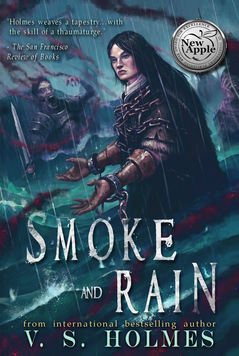 Smoke Rain Reforged Series by V. S. Holmes
Smoke Rain Reforged Series by V. S. Holmes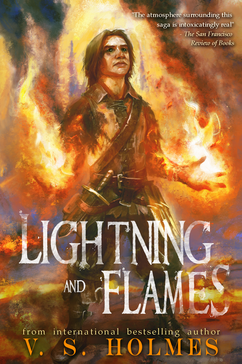 Lightning and Flames Reforged Series by V. S. Holmes
Lightning and Flames Reforged Series by V. S. Holmes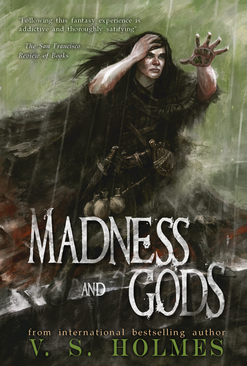 Madness and Gods Reforged Series by V. S. Holmes
Madness and Gods Reforged Series by V. S. HolmesThe Nel Bently – STARSEDGE science fiction universe is a shared world with author Cameron J. Quinn. How did a shared universe come to be?
It started out as just trading Easter eggs with my CP–our characters would read each other’s books on-page, or reference a side character from the other’s work. Then Nel, rake that she is, wound up being the ex of one of Cameron’s characters and it just went from there. Nel appears in the second season of Cameron’s Starsboro Chronicles and Tabby, Nel’s ex, makes a life-saving appearance in my second Nel book, Drifters.
How do you and Cameron J. Quinn keep consistency across multiple novels?
It’s tricky! We discuss our work throughout the process and have a running timeline in a Google Doc where we put all world-changing events including–but not limited to–zombie testing facilities, huge explosions, alien invasion, and so forth. Whenever anything big is going to happen we jump on a video-chat and hash it out with the existing canon. Reading the other books in the world isn’t necessary to understand either of our series, and her subgenres are urban fantasy vs. my hard sci-fi, but it certainly adds to the world.
You happen to hit two big checkmarks for me – archeology and Tiny Homes. How has your archeology background reflected your writing?
I love it when I find a fellow arch nerd! Unlike Nel, I do contract archaeology, which is a strange hybrid between a migrant cowpoke lifestyle and field science. Archaeology affords me the ability to travel to more obscure, rural places. Many of the anecdotes in Nel Bently are directly inspired by the places and people I encounter. Additionally, archaeology is the study of how people lived and related to one another and their environment in the past. Writing, for me, is essentially the same search for the how and why of characters–ultimately searching for the truth of the story. The only difference is the first requires steel-toes and shovels and the latter a mental machete and the arguably more dangerous wilderness of my mind.
What is it like living in a Tiny Home?
An adventure! I built it myself over several years while staying with my parents to help care for my father. As far as size goes, both my spouse and I are used to small quarters, since I married a fellow archaeologist. The tiny house is larger and better designed than the vast majority of the motels we wind up in, and we’re used to giving each other space without actually physically having “space.” A lot of the tiny house depictions romanticize it an uncomfortable way, but tiny living was a way to pay for housing out of pocket (which is why it took 5 years to build 272 sq feet!), but finding places to park isn’t easy, and we were privileged to have a space to stay while we built. In this country it’s the only way we can afford to have a place of our own, though, and we’re happy to make a few sacrifices for that.
Any advice you’d like to share with aspiring authors?
The publishing industry is daunting and full of gatekeepers–stick to your guns, and when you’re uncertain or pulled from your moorings, look within. Writing is a marathon, so don’t quit your day job right away! This work is hard, but so worth it.
Let’s thank V. S. Holmes for joining us again to the blog!
Thank you so much for having me by–what great questions!
You can find their latest work on their website, amazon, and the various links below:
The post V. S. Holmes Award-Winning Fantasy & Sci-Fi Author’s new novel Blood and Mercy appeared first on Konn Lavery.
July 7, 2020
Living With 14 Years of The Doubt Demon
A decade is a long time to be picking away at something. A decade and a half show serious commitment, or maybe it sprouts from something foul. Perhaps you’ve clung onto the years because of the dark whispers you hear in the back of your mind. I know I have. The Doubt Demon. His grasp can be firm and the struggle begins. He’d win some, and I’d win others.
I didn’t quite spend 15 years when it came to writing Mental Damnation. I completed a year before – take that Doubt Demon! Fourteen years later, the fourth and final novel in the Mental Damnation series is here. The journey has been one hell of a process. I’ll share with you how it all started and how I got into writing. The process involved the all-too-familiar Doubt Demon that all artists endure. In the case of writing, the old saying of “just keep writing,” said by many great writers, is too true.
The tale of Damnation’s creation that I will share with you is about persistence and just plain old stubbornness – for better or worse. It should help you avoid some of the mistakes that I made and encourage you to not fall victim to your Doubt Demon’s words. The Mental Damnation tetralogy is a long, non-linear process that I hope will be reassuring with your writing. I also don’t wish for you to take 14 years – or more – to complete the story. If you do, know that you’re not alone. We all fall victim to the Doubt Demon. So, to get to the origins of all of this, we need to go back many years.
Let’s jump into the Time Machine and Go Way… Way… Back to 1998
Mental Damnation is the story that made me want to pursue a writing career, starting professionally in 2012 with the first release, Reality. Eight years later, here we are with the fourth and final book. However, like most writers, my interest in writing did not start with the first book release. I’ve been writing for most of my life and the essence of Mental Damnation has been there. The story has encased my thoughts, ideas, and ultimately dictating what I did with my writing. The pros? It made me persistent. The cons? It caused me to act hastily and fueled the Doubt Demon’s power.
The Evil Seed
Since I was a kid, I have been writing stories and created a fantasy world in 1998, when I was eight years old. It started as a board game that I called The New Island of War, which had backstories to the game and characters. Eventually, the manual mutated into a full novel that I wrote at the age of 12. The book is precisely the type of terrible writing you’d expect from a 12-year-old. Because of that, it will never see the light of day. That novel did teach me about writing and world-building, and ultimately The New Island of War was the mother of Mental Damnation. Vazeleads, paladins, the Kingdom of Zingalg, and many other details originate from the story. For some reason, I held onto these concepts throughout my childhood. It was the initial flame for my writing. The same fire (or muse) that we all have when it comes to our craft. The power that makes the Doubt Demon quiver.
The New Island of War world began to evolve and change as I entered my teens. In these years, I wrote another horrendous manuscript– even worse than the first – and started to develop the character of Malpherities. Krista and Darkwing were established in The New Island of War world. The primary actors in the Mental Damnation storyline were born, fueling the flame.
The Doubt Demon hadn’t cast his net yet. During my childhood, I did the wise thing unknowingly and kept writing, no matter what. Being young and not published, I had the freedom to explore new ideas. Good concepts and terrible ones were all sprouting from my fingers. I didn’t look at it with a critical eye – a double-edged sword that polishes your work and feeds the Doubt Demon. If you haven’t published a book, embrace this time to write wild and write free.
Hopping back into the Time Machine and Going Forward
In 2006 the first manuscript of Mental Damnation was made. I’d written it during high school after sketching out a pencil illustration of Krista split between the real world and hell. She was part of this massive multi-story world I was forging, and I thought it would be interesting to create an origin story for her. The name Mental Damnation sketched above her, and it stuck.
While in math class, I continued to sketch out illustrations and plot the story. During evenings and weekends, I worked on the manuscript. The original story had about 193,000 words and took the characters on a completely different trajectory from where the story is today. The ever-burning flame kept the story and characters alive.
The Original Damnation
The first draft of Mental Damnation was going to be called A Plagued Heart and would be part of a trilogy. A Plagued Heart only had two copies printed at home and hand bound. They still exist today.
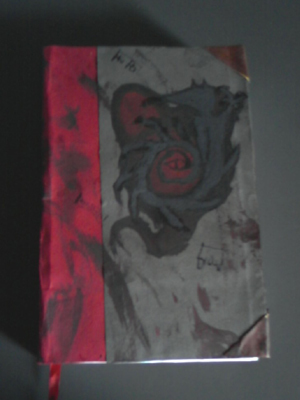
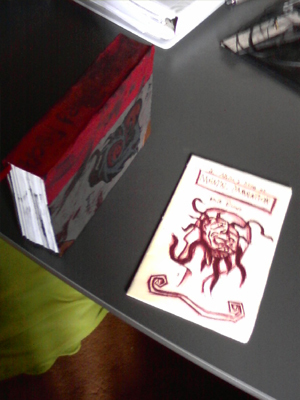
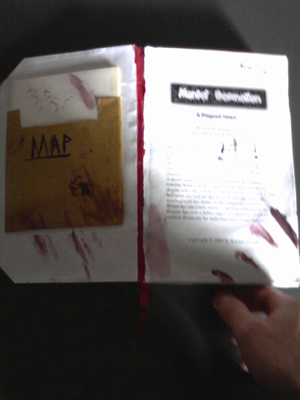
The second book, Sovereign Lust, was fully outlined chapter by chapter. Complimentary illustrations were ready to go. Thankfully, I never did complete that plot. The essence of the original three-part story did make it into the tetralogy of Mental Damnation seen in the conclusion and the subplots. I believed I had a golden story. A publisher would surely take this masterpiece. I’d start my writing career after graduating high school and be set for life. The world couldn’t touch me. Like all teenagers, I was invincible.


Thrown from the Throne
The dream-like fantasy was short-lived. I had shelved the concept of being a writer for years. The classic “I’m not good enough” or “I’ll never make it, why bother?” began to fill my mind. There was an ever-present whispering skepticism in my actions. The Doubt Demon made himself known. He cast two spells:
I was a teenage boy and began to concern myself about being cool, thinking about what other kids thought, so I didn’t take it seriously.I had submitted the original manuscript to some publishers. I heard back from one and it was rightfully so rejected. As an emotional teen, I took this way more to heart that I should have.
The Doubt Demon made his first attack. I decided the work wasn’t worth it, and I didn’t have what it took to be a writer. Near the end of high school, I wondered what the hell I was going to do with my life. I didn’t want to keep working retail, and I certainly wasn’t going to be a writer. After all, I got rejected, which was the end of everything. The Doubt Demon was victorious.
Resurrecting the Damned: Fast Forwarding to 2011
A year after I graduated from college, I was brought into the faculty and was teaching full-time at the school. Self-publishing was beginning to become a legitimate way of getting your work out there without dishing out thousands of dollars. The school was also a positive environment. A co-worker and good friend, and I were chatting about hobbies during a break. Naturally, writing came up. She was curious about what I wrote. I hadn’t touched writing since 2006. For some reason, I decided to share the book. Maybe it was that flame still going, even though I thought I had smothered it with the help of doubt. My friend happened to be the first person outside of my immediate family to read any of my writing. Slap that with the destructive thoughts of teenage me being rejected resulted in a poten potion of nervousness. Despite the Doubt Demon whispering those same old words, I sent the original A Plagued Heart manuscript to my friend. What did I have to lose? I was now a graphic designer. Writing was a silly thing in my past.
The next day, she said she found the book quite terrifying and was unable to finish reading it. She put her laptop in the freezer. I didn’t believe her. For context, Mental Damnation is heavily supernatural and demonic. My friend has a background in Wiccan. She told me she thought I had a story worth pursuing. These were encouraging words. Who knew talking about and sharing your work would be useful? Damn right it is. Share your work and talk about it. No one else is going to.
First Editions: 2012 to 2014
In the more recent history, Reality was the first book I ever released. The self-published manuscript had substantial revisions from the A Plagued Heart storyline. My editor was quite patient with me. I was so eager to get the book out there. I didn’t understand the number of errors it had, and I don’t think I wanted to.
Still, Reality came out in 2012. It happened to be one-third of the A Plagued Heart manuscript. The book was justifiably criticized for falling into narrative clichés and clearly showed the immaturity in my abilities to tell a story. The design and formatting screamed self-published (in the wrong way that gives self-publishing the stipulation it still has today).
I marched on and applied what readers told me with the release of Dream in early 2014. The new book was intended to be read without having prior knowledge of that first book Reality. The second installment of Mental Damnation was well received and reached the bestsellers list in Edmonton.
The third book, Fusion, followed in the fall if 2014. These three books made up only two-thirds of the original A Plagued Heart manuscript. The inner flame was burning for the story of Mental Damnation which was incomplete. With three years on my belt, I knew that the last third of A Plagued Heart was not right for the storyline anymore. I had grown wiser as a writer, writing and revising the manuscript every day. The persistent grind of the craft had proven justified.



The Break: 2015 to 2016
After the release of Fusion, I took a break from Mental Damnation. Three years of revising that old A Plagued Heart manuscript burnt me out. I needed to step away from the story. I was growing as a writer and began to conjure new stories I wanted to explore. Mental Damnation was shelved… again. Unlike last time, I continued to write. For NaNoWriMo of 2015, I wrote the horror novel Seed Me and, in 2016, the thriller YEGman.
After the release of Seed Me in the summer of 2016, I still felt that flame burning. Seed Me was my most successful launch to date. It won an award. The Doubt Demon’s power was dwindling. With my newfound writing knowledge, I decided to revisit Mental Damnation and finish the series once and for all. Boy, was I wrong.
I was sitting in a café with all three books of Mental Damnation with me, ready to work on the next novel in the series. I skimmed through the pages of each book, thinking I’d brush up on the storyline and the world. Instantly I started to identify the cliché narrative mistakes, plot holes, and a lot of redundant sentences. How did I not see these before? There is no way I could continue the series as is. At the café, I decided if I ever wanted to finish Mental Damnation, I had to go back and revise the story AGAIN.
Second Editions and the Finale: 2017 to 2020
Here I was, revising Mental Damnation again. I couldn’t help but think it was a waste of my time. I wasn’t sure if existing fans would be supportive. I was beginning to think I was just recycling old work. Maybe I was destined to re-release Mental Damnation forever, like some literary mutant offspring of the never-ending new Star Wars release editions. The Doubt Demon’s strength had risen.
I was wrong on all accounts. Fans were supportive and excited. My editors thought this was something new and fresh. During the revisions of Reality in 2016, the story came to life. I could clearly see the ending, and the narrator’s voice was bright. The years of constant writing were paying off. The loose ends, unclear subplots, and the central arch were all coming together. The conclusion was near. The Doubt Demon cried.
The second edition of Reality came out in the spring of 2017, followed by Dream in the fall. Fans loved the new story. The new branding also attracted new readers because the design of the books looked professional. Purity (renamed from Fusion) came out in the fall of 2018. Mental Damnation was on its way to being complete.



Yet, I took another detour in the spring of 2018. An opportunity came up that I couldn’t pass down. I met the creators of the Rutherford Manor universe at the Calgary Horror Con. Our conversation evolved into having me contribute to their world with a new novel. Wow. There was no way I could turn that down. I took a detour, and Mental Damnation sat shelved for the third time.
Unlike the previous two setbacks, this came from a place of positivity. There was no Doubt Demon. I wasn’t moping around, nor was I burnt out. I was driven. In 2018 NaNoWriMo, I wrote my contribution to the Rutherford Manor universe with the summer of 2019 release, The White Hand. The sequel Fire, Pain, & Ruin followed a year later.
During the two years of writing the Rutherford Manor books, I did not forget about Mental Damnation. The fire was there. The Doubt Demon was panicking to find new ways of attacking. I had grown as a writer, and fans wanted to know how the fantasy series ended. The incomplete plot burned in the back of my soul and was too much for the Doubt Demon. Mental Damnation was the story that got me started into writing as a kid, and it never had a conclusion. The story needed justice. The Doubt Demon was unsuccessful.
The Holy Words of Damnation
In January of 2019, once again, I took all three books of the Mental Damnation series and read them to make sure I understood every detail of this 13-year-old story. While reading the three books, I was outlining for book four. Then, I spotted a stylistic mistake. Passable, but it could be better. Then a room for improvement, and another. I thought, “imagine if I added some more foreshadowing in book 1”. I wanted to make revisions. The thought about third editions entered my mind. The second editions weren’t good enough. The Doubt Demon had found a new spell to cast.
I entered a new battle with the wicked Doubt Demon. His powers were multiplying. I felt helpless, forever trapped in this dance going back and forth. This manuscript would continue to mutate and evolve as I grew as a writer. I would forever see mistakes and room for improvement. Until the wise words of my college instructor returned. He said, “a project is never done. It is just due.”. Echos of similar quotes followed from Shawn Coyne in his book The Story Grid. He said you can either continue to work on the next great literary fiction, treating it like a lottery ticket, or you can keep writing and move on.
Yes. Of course. They were right. Mental Damnation was never going to end if I kept coming back to it. Self-publishing gave me the power to do so. The Doubt Demon was using that against me. That couldn’t happen. Mental Damnation needed to be finished so I could move on with my life and give readers the ending they deserve.
I locked the second editions in place, concluding that the first three books were written in stone as the holy words of Damnation. I needed to work with what these books had to offer and find a way to bring the story to a satisfying end. That was my job as a writer. It was time to put this old boy to rest. The Doubt Demon wailed in the agony of his defeat. He had no more tricks.
14 Years Later: Mortal
In the summer of 2019, I completed the first draft of Mortal while juggling Fire, Pain, & Ruin. I worked longer hours than I ever have. The flame was bright, casting out all shadows that the Doubt Demon would cower in, leaving him exposed in the light.

Now in 2020, the Mental Damnation storyline ends. I am beyond excited to get the story out into the world and share it with everyone who supported me over the 14-year journey. I hope that my tale of success, failure, and the many years of battling the Doubt Demon, will offer encouragement to you. Be persistent. Be stubborn.
As writers, our job is to keep writing stories. We all experience our form of a Doubt Demon. All artists do. They never go away. We come out victorious, and they will return with new whispering words and new spells. We must defeat them after every new trial they put us through, as is the natural life of a creative.
There’s no point in fixating on a single manuscript for years on end, listening to the Doubt Demon to the point where you’re unsatisfied with it and, even worse, quit writing entirely. Writers write. Everyone in the industry will tell you this, and I am here to tell you again. Don’t give up. Keep the flame alive and finish that story. If you need a break or need to take a detour, go for it. Just keep writing.
The post Living With 14 Years of The Doubt Demon appeared first on Konn Lavery.
June 25, 2020
Going Digital
My marketing has primarily been in person through book signings, conventions, and public speaking events. Of course, in 2020, all that changed and going digital is key. Yes, I am a graphic designer and web developer by trade. People mistake me as either an I.T. guy or a marketing guru. Graphic design and web development (on their own, let alone together) are entirely separate skills from traditional or online marketing. Promoting in the digital space has some crossover in the real world in terms of theory, which helps. In the end, online and traditional are different arenas—time to buckle up and learn something new by going digital.
Welcome to Another Edition of Unprocessed Thoughts
Everyone has had the pandemic affect them, and I won’t dig into that too far. But let me say again, I have completed a LOT of projects in the past few months. Many of them haven’t seen the light of day yet. Their time will come.
There is a mammoth-of-a-task looming at hand, for I find myself in silence. There is nothing but dead air. The strengths I once had while interacting with fans and engaging new ones have fizzled out. In-person events are a thing of the past! Now the world has been shot into the digital realm, and like many other authors, its time to find out how going digital works.
Going Digital A Little Late
Over the past decade, there has been a massive increase in online noise. I am directly involved by building websites for people over these ten years. The ever-increasing digital smothering static is from tech accessibility, access to the web, social media, and distribution companies. These platforms make it easier than ever for each person to have their unique voice. Hashtags, search engines, and categories help people have their voices heard. All of it will make or break your ability to find and maintain your audience.
Like many authors whose strengths were in person, I am going digital going digital and trying to manoeuvre through the vast sea of online noise. Some authors have been learning this over the past decade and have been quite successful. I suppose it is better late than never. The irony of being a writer is I find my voice does not come across well online. My personality and the emotion that I can express is lost digitally. Thankfully, I am not the only one.
Pushing the silly sorrow aside, I have read some interesting articles on Bookbub and booknetcanada.ca that both show a large group of people in the world are reading as of today. These readers are familiar with the e-book world and are hungry for content. Just like everyone else, readers have more time, and they choose their time reading.
Am I Lazy? Or no Time?
Between completing Fire, Pain, & Ruin, and Mortal: Part IV of Mental Damnation, I have not had a ton of time during the pandemic. Plus, the graphic design and web development work keeps me on ridged time to complete urgent projects. So, I have not had a lot of flex space to let me go digital.
Then in the back of my mind, I know I’m procrastinating, and the hard to swallow truth pill is I do not enjoy online marketing. I cannot say I know any authors who enjoy marketing. As a whole, we would much rather be working on the next book. It’s like having dessert before dinner. It’s way better. However, we authors have to promote ourselves, whether you’re traditional, indie or hybrid. Especially now more than ever since online marketing has become a key to make a book sale.
Live and Let Live
Now that the fourth and concluding novel of Mental Damnation is soon-to-be-released, it’s time to find a way to reach new audiences and share the books with people. I do have a couple of manuscripts on the go, and a plethora of half-baked ideas written down or floating in the vast chamber of my head, but I shouldn’t chase the next shiny thing. I should eat dinner first by going digital and surfing the web like a digital book signing.
I also have other interests like music. That sounds like more fun than marketing. There’s that procrastinating devil again. Marketing is work, and I have a lot of graphic design/web development work right now. So, I would prefer some fun. Plus, the good thing about books is they never lose their value. As writers, time away from the keyboard is just as crucial as the typing. Taking time off is a classic way to jolt new life into your creativity and even energize yourself to do the work you don’t like.
Beer Note: Beau’s Full Time I.P.A
For this month, I have tried several new beers. I picked this one because it was the most recent in my memory. The unfiltered organic beer comes in 4-pack 473ml cans and is truly unfiltered. It’s a strong taste with a tropical flavour. I can see how it won an award, but my tastes would prefer only one before switching to something more filtered.
The post Going Digital appeared first on Konn Lavery.
June 22, 2020
#YYCTeachers Exclusives
In support of the Alberta province’s, and the world’s, current state, I’m pleased to participate in the We Are Calgary #YYCTeachers support program throughout the summer!
If you are a teacher, or know of any teachers, you can contact We Are Calgary via email at: aboutcalgary@gmail.com to learn about the discounts/freebies from my work, and other authors involved.
FAQs
How do they prove that they are teachers?
Every Calgary Teacher has CBE issued ID.
How are redemptions being managed?
List, marketing and Email all via We Are Calgary AboutCalgary@gmail.comWho do we provide as a contact and the give information to?
Jennifer Cockton Community Connector with We Are Calgary AboutCalgary@gmail.com
The post #YYCTeachers Exclusives appeared first on Konn Lavery.
June 17, 2020
Taylorism
The world has been streamlined. Scientific management has reached the peak of human ability. The machines will improve on our genetics. Taylorism is June’s short story that brings you into a scifi horror story of synthesized workflow, forever changing the human species.
Taylorism
Working diligently gives you respect amongst your peers, helps you avoid trouble, and gets the job done more efficiently. I know this because of my strong work ethic. My coworkers always wonder how I can multitask, taking on several projects at a time, all while attending a video conference call. Boom. There is no secret to my ability other than focused hard work.
You hear about people who claim that working hard is just spinning your tires. These types of people will say all you have to do is delegate tasks and work smart. I don’t buy that. Those are lazy people that don’t know how to do what needs to be done. If they knew, they would save themselves the effort of trying to scheme a new way to cut corners. Working smart–give me a break.
Each morning I grab my cup of coffee from the café across the street, chat it up, and make it to the office. The boss doesn’t mind if I am a little late sometimes. The relaxed work schedule is a good model as long as the work is completed. The loose policy was good before the company buyout. The creative work environment with lucid roles is a thing of the past. Manageficient Enterprises has been in the process of absorbing design and engineering firms for years. They own just about every company in the industry in one way or another. They’ve cleverly positioned themselves as an umbrella company, working in the shadows and letting the smaller companies appear independent.
Manageficient Enterprises’ primary philosophy is maximizing process potential. The C.E.O. has public opinions about synthesizing workflows to capture human capacities. It sounds like a bunch of corporate jargon if you ask me. Now, I’ve seen the synthesized workflows put into place. After half a decade, Manageficient Enterprises championed the C.H.I.T. age. Conditioning Human Initiation of Transcendence. Yeah, now things start to sound like a new-age cult.
Machines. Productivity Software. A.I. Milestone Tracking. Workflow Processes. Single-Task Functions. The list can go on. Manageficient Enterprises had revamped our office like they did the world. They’ve patented unique energy solutions, allowing robots to run for weeks before recharging. The damn machines were installed on every desk, in every car, store, phone, and computer. They existed both in the physical world and the digital—their purpose: tracking progress on a micro-level.
The organic process of multitasking didn’t fit within the automated reporting systems that fed the machines. If you didn’t meet that micro-milestone or some quote personal function improvement goal un-quote wasn’t satisfying, they would mark it on your yearly review. You can say bye-bye to a salary increase. Well, that was when salaries were still needed.
Now that I look back on it, the machines weren’t terrible. They were a part of the initial company buyout, before the C.H.I.T. age. Manageficient Enterprises pivoted its focus towards the medical industry. They had begun consulting with spiritual leaders as the turn of the decade closed. I didn’t pay too much attention at first until the government got involved.
Look, I am writing this down on an e-paper I found. If you read this, it means you got out. I’m running out of e-paper and good luck finding any type of paper now. Everything synchs into Manageficient Enterprises. So, I will cut to the point. Plus, my memory of how Manageficient Enterprises became the government is fuzzy as humanity entered the C.H.I.T. age.
The world experienced an improvement in productivity, cooperation, and peaceful trading since Manageficient Enterprises synthesized the working world with automated A.I. There was one problem, though. Humans. We weren’t effective in this polished engine. We were unpredictable. Emotional. Animalistic one would say.
The government began announcing we were sick. A yearly vaccine would help improve people’s well being, combat depression, and was required by law. Not long after, the shots occurred twice a year, quarterly, then weekly. People’s personalities changed. Their individuality started to dwindle. I began experiencing long periods of the day where I thought like everyone else, finishing people’s sentences as they did mine. Our species had officially entered the C.H.I.T. age.
Those injections weren’t just to combat depression and make us good workers. Oh no. We were so wrong. A decade of these injections continued, manipulating our minds, changing the way we see the world. We became numb to our emotions as our thoughts focused on our milestone tasks. Our limbs began to weaken. Some of us couldn’t walk. The machines were pleased.
I didn’t need to get my cup of coffee every morning. Hell, I didn’t even see a point in leaving work to go home. None of us did. Money was pointless since the machines fed and cleaned us at our desks. No one enjoyed the simple recreational aspects of life. We had become worker ants who do not question their one function for the colony. We’re all connected to tubes aiding in bodily functions. I wonder why human workers were needed at all. Then again, the human mind doesn’t work in ones and zeros – no matter how many artificial neural networks an A.I. has. The machines need our brains. That is my working theory.
The injections and the tubes made us an organic extension of the machine. Living gears if you will. Of course, organic material has its downfall. Some human genes didn’t react well to the injections. They burned out quickly, and the machines would simply install a new human at a desk to keep progress going.
Losing a human didn’t matter since no individual changes the outcome of progress. Now that all minds are nearly the same, and the work tasks have been reduced to small functions, we’re replaceable. Let me correct my analogy: we’re cells that are part of a larger organism. Single function entities that assist in feeding the machine new ideas that it cannot do on its own. In a way, we’re like the millions of cells that make up the human body, unaware of the higher being that we’re a part of. I wonder what this half-organic and half-machine entity is capable of thinking.
I’ve reached the end of the page. Let me tell you, seeing the crystal-clear solar-panel towers from the outside the metropolis is a beautiful view. If only I could shield out the sun, those damn machines would power down. Knowing them, they have a backup energy solution. I know they have a tracking device on me, and I can hear the humming of their drones. They’re not far, and then they’ll up my injections and reconnect me to my desk so I can carry out my one function for the higher entity. Who knew humanity would have assimilated into a single organism in the name of corporate efficiency?

The post Taylorism appeared first on Konn Lavery.
June 10, 2020
Hugo and Nebula Award Winn Author Robert J. Sawyer’s New Novel, The Oppenheimer Alternative
For June’s guest author, I am pleased to welcome back the Canadian science fiction author Robert J. Sawyer to discuss his latest novel, The Oppenheimer Alternative. Robert joined us in 2017 to discuss his writing career and his book Quantum Night. He is the only Canadian, and one of eight writers, to ever win all three of the world’s top Science Fiction awards for best novel of the year. Robert is also a member of the Order of Canada and has had his writing converted into television, as seen in the ABC TV series FlashForward.
Let’s welcome Robert J. Sawyer back to the blog and learn about his new novel, The Oppenheimer Alternative.
Welcome, Robert! Can you give us a summary of The Oppenheimer Alternative?
The Manhattan Project assembled the greatest physicists ever, under the scientific direction of J. Robert Oppenheimer. They came together with what they thought was a noble purpose: to defeat Adolf Hitler. But Hitler did what they could not, ending with a single bullet to his own head the war in Europe.
And yet they pressed on. One of those physicists, Emilo Segrè, said, “Hitler was the personification of evil and the primary justification for the atomic-bomb work. Now that the bomb could not be used against the Nazis, doubts arose. Those doubts, even if they do not appear in official reports, were discussed in many private conversations.” When those scientists finally succeeded in building the world’s first atomic bomb, Oppenheimer himself said, quoting Hindu scripture, “Now I am become Death, the destroyer of worlds.”
I wanted to give those tortured souls a chance at redemption. Instead of dispersing back into academia, as they really did after the war, I have them stay together to fight an external, natural threat to human existence. If they succeed, they’ll be able to collectively declare, “Now we are become Life, the saviours of our world.”
The Oppenheimer Alternative takes place at a critical point in history: how did this reflect your research process while writing?
Our current year-numbering system is terrible. First, it’s culturally specific; second, it’s even wrong for that culture — Christ was born during Herod’s reign, and Herod bit the big one in 4 B.C. So, if we ever decide to chuck it out and start numbering again, there are only two good initial dates: July 16, 1945, which was the birth of the atomic age with the Trinity test, and July 20, 1969, which is the first time humans ever set foot upon another world. No other milestone for which definite dates are known is as significant as those.
And, as it happens, this year is the 75th anniversary of the first of those events; it seemed like the time was ripe for a critical reassessment of what had really gone into it all. Just as when we looked back on the 50th anniversary of Neil Armstrong’s “one small step” and could see the moonshot as more cold-war posturing than high-minded aspiration, so, too, we can now look at the Manhattan Project not as a saintly attempt to save the world from Nazism but rather as a calculated undertaking to establish the United States as the one-and-only post-War superpower.
How did the idea for The Oppenheimer Alternative come to you?
As always, there were numerous sparks. But one was a TV project I was developing back in 2015 with a Canadian production company about New York in the present day suddenly being cut off from the rest of the world. The team really wasn’t getting anywhere, so I did what I call a “kitchen-sink” pitch: an over-the-top outline, throwing every idea I could think of into the mix, just to jolt our thought processes.
I tossed Oppie into that because of a famous exchange he had in a closed-door senate hearing. When a senator asked him whether “three or four men couldn’t smuggle units of an atomic bomb into New York and blow up the whole city,” Oppie replied, “Of course it could be done, and people could destroy New York.” The senator then asked, “What instrument would you use to detect an atomic bomb hidden somewhere in a city?,” and Oppie replied cheekily, “A screwdriver” —so you could open each and every suitcase.
The TV project never got anywhere, but the idea of doing something with Oppenheimer stuck with me: a sharp-tongued smartass who liked to tweak the noses of those in power. The more I researched him, the more irresistible I found him as someone to write about.
What were some of the challenges while incorporating real historical figures into the story?
Every single character in the novel is not just real but famous, too: Oppenheimer, Albert Einstein, Richard Feynman, Edward Teller, Leo Szilard, I.I. Rabi, and so on. And so my first duty was to the truth: I had an obligation to represent these people accurately, capturing them as they really were, so that not only historians who have studied them but their surviving family members and friends would say I did them justice. Of course, that didn’t mean sanitizing them: precisely because they were real human beings, they had both human virtues and human flaws, none more so than Oppenheimer himself.
I made a point of showing the book before publication to people who actually knew or were experts on the real historical figures, including Martin J. Sherwin, coauthor of the Pulitzer Prize-winning Oppenheimer biography American Prometheus; my SF-writing colleague Gregory Benford, who was Edward Teller’s grad student; Doug Beason, the former Associate Laboratory Director of the Los Alamos National Lab where Oppie’s part of the Manhattan Project was based, and Jem Rolls, who wrote a fabulous one-man play about Leo Szilard called “The Inventor of All Things.”
Is this your first science fiction novel that merges within the alternate history genre?
It is, but I have a long-standing interest in the genre. Back in 1989, CBC Radio’s flagship documentary series Ideas bought two one-hour programs from me called “What If? An Exploration of Alternative Histories.” For those shows, I got to interview in person all the masters of the field, including those who now are its two superstars, Harry Turtledove and S.M. Stirling, plus Kim Stanley Robinson, Robert Silverberg, and Gregory Benford.
That said, my Hugo Award-winning Hominids and its two sequels, Humans and Hybrids, are alternate prehistory, in a way. It’s such an endlessly fascinating genre: we’ve all asked ourselves, about both our personal lives and the state of the world, how things would be different, and maybe better, if some key event had happened or not happened.
What’s next on your project list?
My great friend Larry Niven says, first and foremost, a writer should “tell me a story.” That’s a fine approach, but it’s not mine. Me, I need to have something to say — some philosophical point I feel is worth articulating with the breadth and nuance that the 100,000 words of a novel afford.
I’ve been doing lots of research reading related to a variety of projects — one about what sorts of human personalities will best adapt to the rise of true artificial intelligence; another about the showmanship behind the early days of frontier paleontology; and a third about how our world will have been changed indelibly by the COVID-19 disaster. But I haven’t yet found what I’m looking for — something worth saying; something worth me taking years to articulate and my audience taking days to read. When I do, I’ll settle on which of those project will be next.
Unrelated to writing, you’ve talked about offering public speaking as a futurist for corporate and government agencies. Is this something you still do? And what are the common themes you cover as a futurist expert?
Oh, yes. I do it a lot, and I love doing it. The two things I find over and over again are, first, that people don’t realize just how advanced our technology already is — although perhaps the COVID-19 crisis is changing that a bit as people suddenly discover that technologies such as video conferencing, which have actually been around a long time, are mature and robust.
And the second is that people keep fearing that technology will diminish their roles instead of expanding them. One of my favourite keynotes was to a provincial nursing association: nurses were very upset about things that machines were doing that used to be their jobs, but, in fact, taking away repetitive work frees them for an expanded role — including now, in many jurisdictions, prescribing drugs — that was denied to them in the past.
Do you think that the technological singularity is within the next decade?
No. You mentioned my keynote speaking a moment ago. Eighteen years ago, Ray Kurzweil and I gave joint keynotes at the Twelfth Annual Canadian Conference on Intelligent Systems. He said the singularity was near then, and, well — here we are and it hasn’t happened. The singularity — the moment when machines exceed our abilities and render us entirely obsolete and redundant — depends not just on artificial intelligence but on artificial consciousness, and it doesn’t seem like we’re anywhere near having that happen. But if and when it does occur, I hope it’s as beneficent as the emergence of Webmind, which I portray in my WWW trilogy of Wake, Watch, and Wonder.
For aspiring writers, what’s a single piece of advice that you’d offer to them?
Oh my God, dudes — this is your moment! Don’t waste it. COVID-19 is a disaster of gigantic proportions, and I don’t downplay that for an instant, but you will never have this much time off work, this much time off school, this many nights and weekends where you must stay home as you’re having right now.
If you’re someone who wants to be writer and you aren’t writing your heart out right now, well, sorry, you will never make it. Ninety percent of those who want to write say they’d be doing it if they only have the time (the other ten percent — people like me who have already made it — did it even when we didn’t have the time). You’ve got the time now: either write or face up to the fact that you were just making excuses for why you weren’t writing all along and admit that you never were really serious about it in the first place.
Let’s thank Robert J. Sawyer for Joining us!
You can find Robert and his work, including his new novel The Oppenheimer Alternative, from his website and the links below:
sfwriter.comGoodreadsTwitterFacebook The Oppenheimer Alternative

The post Hugo and Nebula Award Winn Author Robert J. Sawyer’s New Novel, The Oppenheimer Alternative appeared first on Konn Lavery.
June 4, 2020
Unsubscribing from an Increasingly Subscription-Based World
Sometimes I blog about topics that aren’t about writing, like the design posts or the Texting or Email for Work? post. The following is the result of the trial run I conceived in November 2019 and started in January 2020. The test involved unsubscribing from an increasingly subscription-based world. In today’s age, we see a massive increase in micro-transactions, monthly services, recurring payments, and subscription-based models in a variety of industries. There used to be a time where you would be able to buy your software and own it. Those days have long since left.
Today, people subscribing to use a product is the new normal. Consumers are also comfortable with brand loyalty, even if it means they don’t truly own their one-time purchases. Take Microsoft’s eBook store, for example. Microsoft ultimately decided to remove their book store, deleting everyone’s books in the process and refunding them for the purchases. The act sparked some outrage, as some books cannot be easily obtained elsewhere, but the rage fizzled out.
Microsoft could do this because it was within their terms of agreement with the consumer. Terms of agreement with a big tech company is a much broader discussion. Let’s stay on topic with subscription models. We all have monthly bills ranging from rent/mortgage, internet, car insurance/payments, phone, power, credit card(s), and tuition fees. The list could go on. You may have even subscribed to some software tools, resource sites, or streaming services. Each of these low-cost items adds up to a large sum every month. Are they all worth the price?
The Personal Realization About Subscription Models
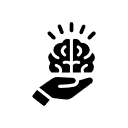
In November 2019, the realization of my monthly subscriptions hit me from two angles. The first was after reading Who Owns the Future? By Jaron Lanier. I could write a whole blog post about how this book has elaborated on my interests in the evolution of big tech and surveillance technology. The book talks about copyright issues rooting from the digital copy function. It explains the more significant problem of Silicon Valley, privatization, and subscription-based models. Jaron Lanier also explores where we will go with technology and how all industries are being assimilated. He also makes a bold recommendation of removing yourself entirely from social media to prevent the manipulation engine from affecting your thoughts and attitude towards life. The book is well worth the read.
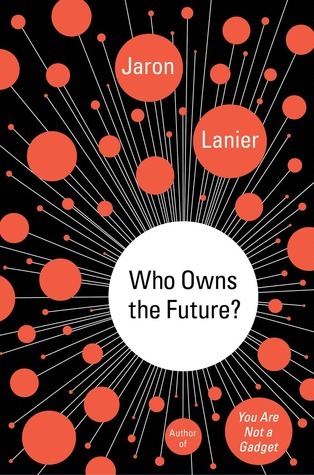 Who Owns the Future? By Jaron Lanier
Who Owns the Future? By Jaron LanierContinuing, the second realization I had was when the web hosting control panel, cPanel, switched over to a pay per licence model. The change happened in July, but the hosting company I use didn’t implement the changes until November, which directly affected the hosting prices I provide for my clients.
At that time, I was also looking for a solution for my accounting. I had been exploring a highly regarded monthly subscription app that has the user act as the bookkeeper. I had also subscribed to industry-standard design software, a more expensive phone plan, multiple cloud storage services, and a couple of streaming services. The addition of cPanel’s new pricing models made me review all of my monthly payments and subscriptions. I wanted to understand where my money was going and how much I would be spending. The monthly costs were higher than I thought, and I began to wonder: what am I using these services for?
Finding Value in What You Use
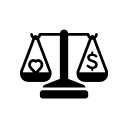
It is easy to forget about what you pay for monthly if it is a few dollars here and ten there. You may also find it convenient to have it ‘just in case.’ I took a hard look at what I subscribe to and found that I didn’t need, nor desired, most of these services.
The cPanel change? I had to reconstruct my server model, letting me reduce the monthly cost. The phone plan? I never reached the data cap, so I found a reduced plan. The accounting app? I ultimately hired a professional accountant firm who is an expert in the field, where I am not. The software? I found competitive one-time payment software that met my needs. The cloud storage? It turns out I was storing files that I didn’t use and hadn’t looked at in years. The streaming services? I got rid of them and started purchasing directly from the distributors and artists.
I couldn’t find value in the subscription services. Ultimately, I realized I didn’t need a lot of them, and there were other options available that didn’t require monthly payments. The one-time fees weren’t overly expensive either as technology has evolved in recent years, making them more affordable. There were a few I kept, like a single cloud storage subscription and my web hosting. In January 2020, I removed five subscriptions that I didn’t need.
I have had friends asked me if I miss the services that I dropped, and I have not. Truthfully, I thought I would lose some of the convenience of streaming music and their playlists or the high-end features of specific software. As of now, I’ve found if I didn’t remember the song’s name, it wasn’t very good, from the start. My work hasn’t been impacted by the software change either. Most of the new tools are just flashy tricks and I have primarily used the same functions for well over fifteen years. It’s the theory that you apply to the tools that makes them effective, not another new shiny software update.
Ultimately, removing the subscriptions has helped me save money, focus more on what I have, and find better means of spending my income. An example would be going out for a nice dinner or buying music directly from musicians instead of them getting the low payment from streaming services.
Owning What You Pay For
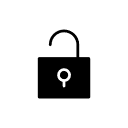
The concept of owning what you pay for is slowly phasing out of society. People pay for expensive homes, obtain mortgages that lock them in for many years. The same can be said about cars. We are bound to the features that our smartphone plans offer us due to the demand of social constructs and work standards. Not too long ago, we operated cellphones as phones and used computers for production. When work was done, the computer stayed at the desk.
We once owned our tech, and now we see far more companies move to a subscription-based service. The model is seen in web tools, programs, apps, and even hardware. The recurrence ties us into a month-to-month system where we do not have ownership of what we possess. We agree to license the usage of the product for a limited time for the comfortable conveniences they offer. The terms ultimately bind us to the service, and we can no longer see our lives without these comforts (which wasn’t that long ago when you look back and somehow we survived).
Why Did Subscription-based models Increase?
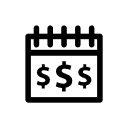
The subscription-based model works exceptionally well for companies. They can charge the services at a lower rate, bringing in more people, and more likely than not, they will have longer-lasting customers. The one-time-by methodology was killing companies. It risked losing people after purchase or them leaving before due to a high price tag. In the end, the recurring payments have offered sustainability for companies and allow a continual cash flow every month, which looks good on the books. Who wouldn’t want to use this model?
The Consumer’s Needs
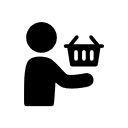
On the flip side, the subscription-based model allows people to have access to more tools and media than ever before. They can enjoy the hassle-free experience. In terms of software, it also cuts down on people obtaining cracked copies. The same can be said about piracy with music, video games, and movies. If the price point is so low, why would anyone bother risking stealing a file online when they can conveniently get a legal copy?
Peace of Mind
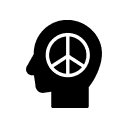
Quality of Time
From a quality standpoint, minimizing the amount of clutter in your life will create a greater appreciation for what you do have. It can also allow you to think about your purchase critically, and when you do, fully invest in it. You’ll find you dislike some things more and enjoy others on a higher level. In the end, your time becomes more intentional, increasing your life’s quality.
Knowledge
From a knowledge standpoint, leaving subscription-based software for work can offer the opportunity to learn a new interface. For me, I’ve been able to explore new creative directions by applying the same design theory from a new perspective. Previously I fell into the trap of passively implementing the design theories I was familiar with, constantly trying new tools to take shortcuts, and I was not expanding my abilities.
Financial
From a financial standpoint, the clarity of knowing exactly where my money goes every month helps as well. Some subscription-based models are paid annually, some bi-annually, while others are month-to-month. These ranging charges can increase someone’s stress level when viewing your bills at the end of the month due to the fluctuation.
Unsubscribing from an Increasingly Subscription-based World
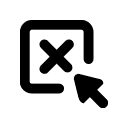
No one is telling you to unsubscribe everything, remove social media, and head for the hills. However, I recommend taking a long hard look at the things you do use and decide if they bring you value. For me, I had previous issues with the subscription-based model. I didn’t like being locked into a company who can change their terms of agreement whenever they see fit and have it impact my life. The products, software, and media I buy I own as is, and it doesn’t change with an update or the company discontinuing the service.
Unsubscribing from an increasingly subscription-based world offers some control back into your life, mental clarity, and lightens the finances. So, can you remove a subscription from your life? How about a second one? Try it. You may be surprised to learn a few things about yourself.
The post Unsubscribing from an Increasingly Subscription-Based World appeared first on Konn Lavery.
May 26, 2020
Short Stories and Transmedia
We are over two months into the pandemic self-isolation. Here in Edmonton, the government has initiated phase one of reopening the economy. Personally, I will continue to wait and stay indoors. Life isn’t too different from my regular work schedule. I have a home office doing contract work and writing. These are both isolating experiences. On the upside, I have been getting lots of short stories and transmedia writing projects completed and near completion. Might as well make use of all the spare not going out. Plus, this won’t last forever. Right?
Welcome to Another Edition of Unprocessed Thoughts
This post isn’t intended to induce fear. The extra time hasn’t all been free. My contract world was hit with a big wave of last-minute projects and overflow projects due to the coronavirus. That’s okay, as a contractor, you want to stash cash in case of a dry spell. However, this did mean less activity online. I’m still alive, and I’m still writing. Most of the month has been spent writing short stories and transmedia pieces, then revising them.
Short Stories and Transmedia Projects
The art of the short story form is fascinating. You’re constrained to a limited amount of words. They are less forgiving than a novel, and ideas need to be compressed into a small amount of space. For the monthly short stories, I have been practising reducing them to 1000 words to see how that changes the pacing, and concepts that can be expressed. So far, it is a lot of fun.
For the past month, I have been working on a short story submission for an anthology. I’m hoping to have more news on this soon – like by the end of the year. I had another short story that I wrote in December that has been accepted into an anthology for this year. Again, more and that to come.
#daily250yeg
The online presence I have been making has been seen on Twitter. The Edmowrimo group initiated the May-long #daily250yeg, which has writers write 250 words per day. It’s been fun to see other writers in the area work on their projects, all in isolation. The conversation and support have been thrilling. I tend to write daily already and will continue to do so. The Twitter updates will be less frequent after me, though. Even now, I keep forgetting to make the daily updates. Whoops.
Transmedia Storytelling
I’ve talked about Transmedia storytelling plenty of times in the past. The short stories and transmedia storytelling have been a big part of the blog for about two years. Art, music, story, and a live reading all engaging with as many senses as possible. Transmedia is one of the prime reasons why I like to tell stories to begin with. With the pandemic, I have been able to focus on a lot of additional media that will be in upcoming works. This includes more visual works based on the stories and instrumental scores.
The extra media has been kept on the down-low since they are well into development and are not quite ready to be presented. Once the stories are written and polished, then the transmedia pieces will be appropriate to share.
That’s All
In summary, lots of cool things are in the works. The summer – and probably the rest of the year – is a bust. I will be spending more time online, promoting existing work and writing new material.
Beer Note: Troubled Monk Pesky Pig Pale Ale
for this month, I’ve tried one of the troubled monk beers. This pale ale sits at a 5% alcohol level and is the light drink that is easy to sip on casually. The pesky pig is something I will come back to down the road. I am also biased because I like pigs.
The post Short Stories and Transmedia appeared first on Konn Lavery.
May 20, 2020
The Smell
Being locked in a bunker as the last survivor isn’t easy to cope with, especially if there’s a otherworldly cleaver-armed monstrosity on the other side of the door. How long can one last in a room of rotting flesh? The Smell is May’s short story that brings you into a claustrophobic horror with a dash of creature feature.
The Smell
One by one, we died. I watched my friends be torn apart like butchered pigs. The giant cleavers on the Bastard swung into them, slicing them up into unrecognizable chunks. At first, there were twelve of us, then there were six, three, and then just me. I’m not afraid to admit that I vomited multiple times, watching in horror as my friends were mangled alive. Eventually, I got to a point where I could not vomit anymore and have become desensitized to the atrocities.
The Bastard took every bit of dignity from my friends and me. We took shits in empty pots and drank our piss just to stay alive. The fusion of human bodily fluids and rotten corpses seeped through the vents. The stench was unbearable. We couldn’t go anywhere inside the underground bunker, and outside… well, everyone knows you cannot go out there. That is straight-up suicide.
I’m not sure how the Bastard managed to get into the bunker, but it did. Thank God Dan was one of those end-of the-world-nut-bags, stocking up on can foods and weapons. Unfortunately, no amount of preparation could have helped in this scenario. The whole world was mutilated. We don’t even know where these bastards came from. Wild rumours sprouted before all communications were cut out. Aliens, underground reptilians, demonic summoning, you name it. Truthfully, I don’t care. I just want to get rid of this god-damned funk.
When the Bastard first got in here, I thought about abandoning the bunker and risking going outside. The idea left my mind as quickly as those cleavers slice through flesh. I remember seeing the footage on the internet. There are thousands, if not millions, of the bastards out there. Humanity has tried to kill them. Hell, twelve of us tried to kill one. Bullets absorb into it, making it howl like a dying dog, but it doesn’t stop. It never stops.
Now I’m the last one in the bunker, gripping my shotgun tightly. When there were several of us, we formulated the final plan to trap it in one of the closed-off storage rooms. The Bastard managed to kill Nora and Pat during the scheme. Pat was supposed to be the bait, luring it into the storage, and we’d shut the air-lock door.
Nora and I got turned around to avoid the Bastard’s sharp cleavers and ended up in the storage room. Poor Pat, he wasn’t quick enough to dodge the attack. He did his best to stray it away while being sliced open in every which way. Nora was too loyal to Pat for her own good. She thought she could save him and blow the Bastard’s head off, wherever the head was. The four cleaver-like limbs were the only distinct parts of its form. Its body changed shape every second, like watching a television with no signal, glitching out. I have to say, Nora went out guns blazing. If we lived in a different time, that type of death would be honourable. Now? it just makes me sad and creates another layer of funk.
We used to hypothesize what its strengths and weaknesses were. We were hopeful twelve-against-one would give us the upper hand. The result: one-on-one. Days have gone by with the Bastard on the other side of the door. I can hear giant cleavers slicing against the steel door from time to time. The Bastard likes to go for long periods of silence, hoping to psych me out. The only weapon I have now is starvation. It can’t feast off the eleven dead forever. So, I wait.
I have several dozen cans of beans and crushed tomatoes, space-grade meat, and one box of bullets. The pots are full of my shit, and I have reverted to relieving myself in one corner of the room. Piss is for the other if I don’t have any spare empty cans. This is no way to live. I’ve wondered if the Bastard would leave, go back to the surface the way it came. Yet, we don’t even know how it got in here. Maybe it is stuck, like when a fly finds a way inside a window but can’t get out.
Eventually, the clawing and howling stopped. Another week went by with no sounds. This was the longest silence-session the Bastard has had. The last record was four days before it started scratching at the door again. I think. Days are hard to tell. The duration was promising. I cling onto any form of hope now. Otherwise, I’d just blow my head off with this shotgun. The stench of the storage room was beyond anything I had smelt before. I wasn’t sure how much longer I could stay in the small space. The funk might kill me.
Scenarios ran through my mind – wondering if I should open the door or keep waiting it out. I still had plenty of food left. Drinking piss got old… And the smell that lingered in my nostrils. I couldn’t take it anymore. I wasn’t sure how long it took me, but I mustered up the strength to stand. I had to get out of here.
I held the shotgun, pointed down, quietly approaching the door. These bastards have good hearing. One step after the other, I reached the door handle, clutching the cold metal with my hand. With one deep inhale, I flicked the lock and swung it open. Shotgun raised. Breath held while scanning the blood-filled hallway. Nothing. Where was it?
My heart pumped rapidly the further down the hall I went, checking every tossed-over boxes, the ceiling, in front and behind me. It was gone. The Bastard went back to wherever it came from, leaving me as the only one to survive the cleavers, stepping on the remains of my dead friends. The stench out here was no better either, it lingers in my nostrils, forever present, unless I left the bunker and embraced death. Wait, the smell was worse, and closer. My trousers were moist and heavy. Great, I shat myself. Add that to the growing pile of funk.
The post The Smell appeared first on Konn Lavery.
May 13, 2020
Ann Charles, Mystery Author of Devil Days in Deadwood
For May we welcome USA Today bestselling author Ann Charles from Northern Arizona who writes mixed-genre mystery novels that are character-driven. She has written multiple contemporary, award-winning, novels in multiple series. When she is not writing fiction, she pens writing-themed articles and shares what she has learned through her workshops.
Let’s welcome Ann Charles to the blog!
Hi Ann Charles, thanks for joining us. Can you give us brief intro about yourself?
I write spicy character-driven mysteries full of comedy, adventure, suspense, romance, and paranormal mayhem. When I’m not dabbling in fiction, I’m spending time with my husband, teenagers, and four cats.
Tell us about your latest release, Devil Days in Deadwood, which is part of the Deadwood Mystery series.
This is the eleventh book in the Deadwood Mystery series, which started with book 1, Nearly Departed in Deadwood.
The Deadwood Mystery series stars Violet Parker, a single mom of almost 10-year-old twins who has moved to Deadwood with her small family to live with her aunt and try a new career as a real estate agent. Throughout the series, Violet struggles to carve out a normal life in spite of a whirlwind of problems (both human and supernatural) that keep her days and nights from being anything but “normal.” Included in these stories is a fun cast of characters who all struggle, screw-up, and entertain readers along with Violet, including her crazy best friend, her fun-loving aunt, a self-appointed bodyguard, and a sexy love interest.
Here is the back cover copy for Devil Days in Deadwood (Deadwood Mystery 11):
“Hell is empty and all the devils are here.” ~William Shakespeare
Violet Parker knows better than to play with devils. They always cheat, especially when lives are at stake. Deadwood’s charming, troublemaking, and soul-sucking devils are no different, and they’re biting at her heels.
But the clock is ticking and Violet has no choice—she must risk her life to save her treasured Aunt Zoe. With any luck, she might be able to trick the devils and beat the old terrors at their own game. If not, Deadwood could end up short one Executioner.
“Executioners don’t duck, they swing.” ~Violet Parker
Currently there are four forthcoming books on the Future Books page, nice! How do you keep organized with multiple novels on the go?
It keeps me busy and out of trouble. I have help from a story worldkeeper who puts detailed notes about each book and series into a document for me to reference as I write. In addition, before I start a new book in any series, I read through all of the past books to reacquaint my old brain with all that happened before and ideas I had in the works. Some series have 5+ books in them, so this process can take a bit, but it helps me to keep the series consistent.
Do you enjoy writing series more or stand-alone novels?
Series, definitely. That way I don’t have to say “goodbye” to characters, and I enjoy the challenge of a longer series timeline. It’s fun to find ways to keep a series fresh and entertaining. I also like to explore character growth, and a series offers more time for that on the page.
Do you have a favourite piece that you’ve written, or are they all different?
All are different and I enjoy taking breaks from one series to dive into another for a few months. Changing series between books keeps the story from growing stale for me.
Did you always intend to be a writer?
No, but I always loved learning about far off places and imagining stories and lives happening within them.
You also feature your illustrations on your site, can you share some more insight into the illustrations?
My brother, C.S. Kunkle, is an artist. From the start of this “going indie” venture, he was interested in helping with the cover art and illustrations. We started back with the first book I published, Nearly Departed in Deadwood, and have continued working together on almost all of my books ever since. My readers enjoy having a few illustrations scattered throughout my books. It makes the stories come alive a little more.
Any advice you’d like to share with aspiring authors?
Perseverance is key. This is not a make-money-quick game anymore. It’s costly on both the financial front and time-wise, and it will also take every bit of energy you throw at it and want more. You have to be able to write books that can compete with best sellers both in story and as a product sitting on the shelf. Today, more than ever, you also have to know how to promote your books on social media or via in-person signings. However, it can be a lot of fun and full of wonderful high points. You just have to stick to it and not give up.
Let’s thank Ann Charles for joining us again to the blog!
You can find her latest novel on her website, amazon, and the various links below:
Back Cover Synopsis

“Hell is empty and all the devils are here.” ~William Shakespeare
Violet Parker knows better than to play with devils. They always cheat, especially when lives are at stake. Deadwood’s charming, troublemaking, and soul-sucking devils are no different, and they’re biting at her heels.
But the clock is ticking and Violet has no choice—she must risk her life to save her treasured Aunt Zoe. With any luck, she might be able to trick the devils and beat the old terrors at their own game. If not, Deadwood could end up short one Executioner.
“Executioners don’t duck, they swing.” ~Violet Parker
Pre-order your copy today!
**********
KOBO: https://www.kobo.com/us/en/ebook/devil-days-in-deadwood
NOOK: https://www.barnesandnoble.com/w/devil-days-in-deadwood-ann-charles/1136973124?ean=2940162661603
APPLE: https://books.apple.com/us/book/devil-days-in-deadwood/id1511805855
The post Ann Charles, Mystery Author of Devil Days in Deadwood appeared first on Konn Lavery.
Posts from konnlavery.com
- Konn Lavery's profile
- 156 followers



